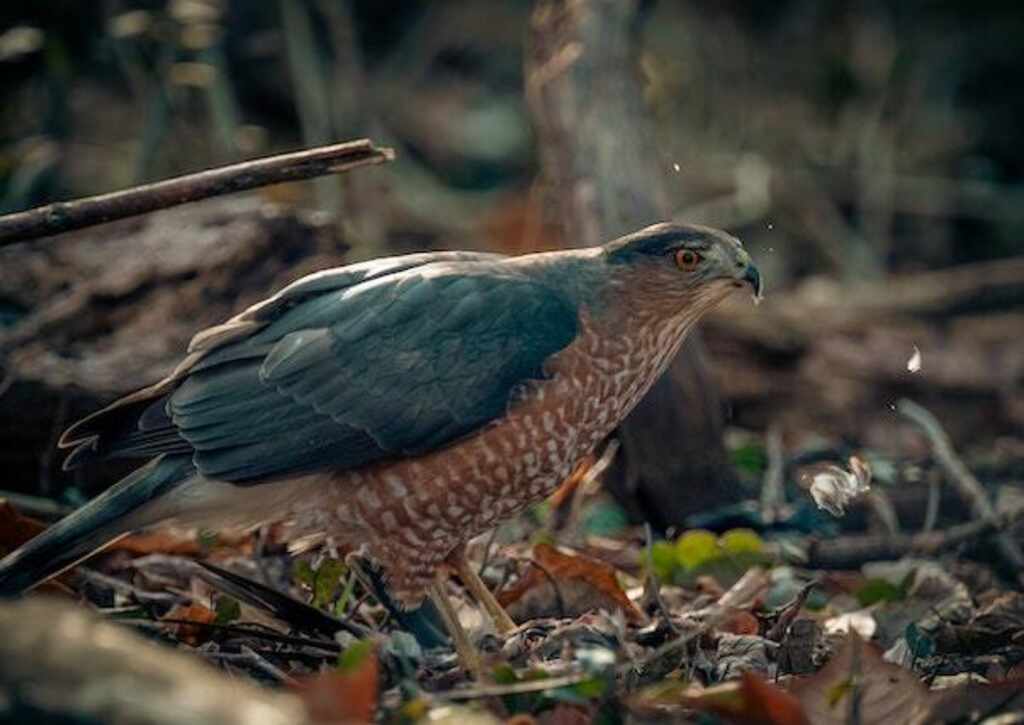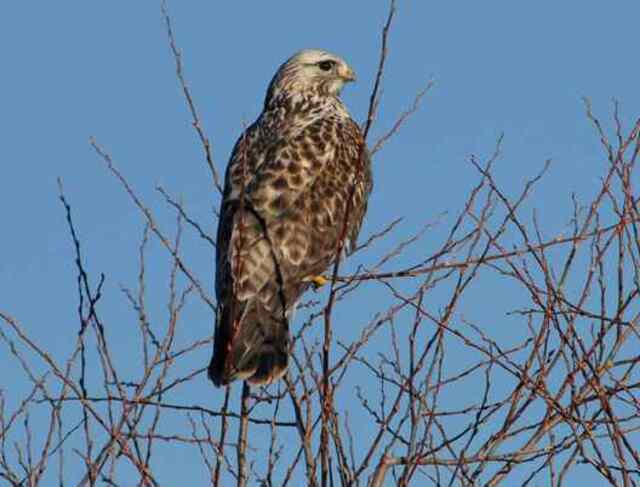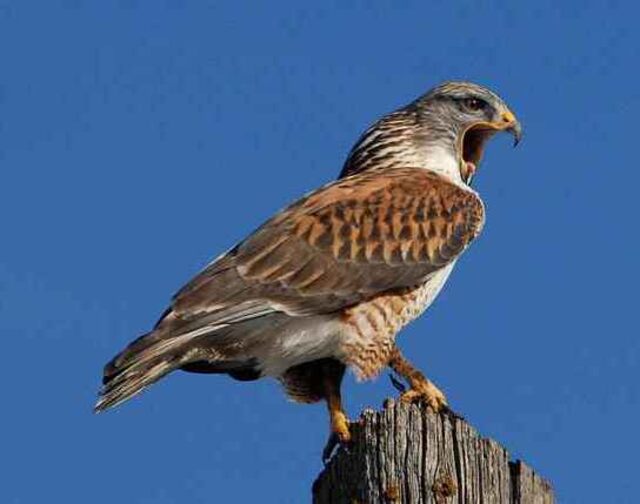According to a recent survey, over 85 million Americans participate in bird feeding activities, spending billions of dollars annually on birdseed and other bird food.
One common concern among bird enthusiasts is whether hawks pose a threat to their backyard birds, particularly when it comes to bird seed.
Hawks are known for their predatory behavior and are often seen swooping down to catch their prey.
However, the question remains: do hawks eat bird seed? Understanding the feeding habits of hawks is essential to address this question.
Hawks are birds of prey that hunt and feed on a variety of animals, including small mammals, reptiles, insects, and other birds.
Their hunting techniques vary depending on the species, but they all share the same predatory instincts.
While hawks are not known to feed on bird seed, they may be attracted to areas with high bird activity, which could put your backyard birds at risk.
In this article, we will explore the feeding habits of hawks, the factors that may influence their diet, and the steps you can take to protect your feathered friends.
Table of Contents
- 1 Key Takeaways
- 2 Overview of Hawks and Their Diet
- 3 What Do Hawks Typically Eat?
- 4 Factors That May Influence a Hawk’s Diet
- 5 Do Hawks Eat Bird Seed?
- 6 How to Protect Your Backyard Birds
- 7 Other Tips for Keeping Hawks Away
- 8 Understanding the Importance of Hawks in the Ecosystem
- 9 Conservation Efforts for Hawks
- 10 How to Coexist with Hawks
- 11 Frequently Asked Questions
- 12 Conclusion
- 13 Author
Key Takeaways
- Hawks are known for their predatory behavior and hunt a variety of animals, but they are not known to feed on birdseed.
- Hawks are attracted to areas with high bird activity, and their diet is influenced by their food sources, habitat, and hunting skills, which can be impacted by human activity.
- Protecting backyard birds is important for their safety and survival, and can be achieved by attracting them to safe areas with food and water sources and deterring predators with protective covers, netting, decoys, reflective materials, and scare tactics.
- Choosing the right bird feeder and keeping pets indoors for safety, as well as covering windows to prevent collisions with glass, can also help protect backyard birds.
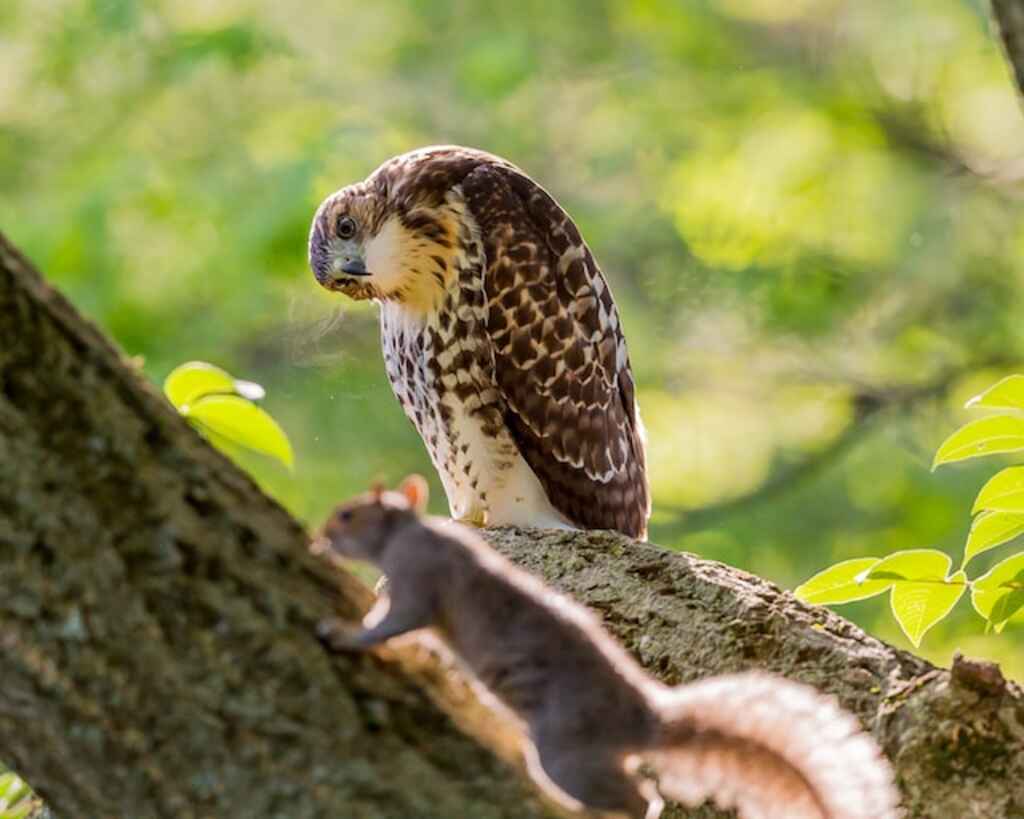
Overview of Hawks and Their Diet
Hawks are predatory birds that have a varied diet consisting primarily of small mammals, such as rodents and rabbits, as well as birds, reptiles, and insects.
There are many species of hawks, each with their own unique hunting behavior.
Some hawks, like the Red-tailed Hawk, will perch in trees or on telephone poles and scan the ground for prey.
Others, like the Cooper’s Hawk, are known for their agility and ability to maneuver through dense forests to catch their prey.
Despite their predatory nature, hawks are also opportunistic feeders and will eat carrion or even consume bird seed if it is available.
However, bird seed is not a typical part of a hawk’s diet and they are much more likely to hunt for their food.
In the next section, we will explore what hawks typically eat in more detail.
What Do Hawks Typically Eat?
Birds of prey typically consume a diverse range of prey items, including small mammals, reptiles, and other birds.
Hawks, in particular, are known for their hunting prowess and their ability to take down prey that is much larger than themselves.
They are also known for their varied hunting strategies, which can include soaring high above their prey and diving down to catch it, or stealthily approaching their prey from the ground.
In terms of their diet, hawks typically consume a variety of small mammals, such as rodents and rabbits, as well as birds and reptiles.
Their hunting behavior is influenced by a number of factors, including the availability of prey in their environment, their location, and their own physical capabilities.
Overall, hawks are skilled hunters that are capable of adapting their hunting strategies to suit their environment and the prey that is available to them.
Factors that may influence a hawk’s diet include the availability of food sources, their habitat, and their hunting skills and abilities.
Factors That May Influence a Hawk’s Diet
The dietary habits of hawks are influenced by a variety of factors, including the availability of prey in their environment, their location, and their physical capabilities.
Factors that affect hawk diet may include the type of habitat they occupy, the time of year, and the presence of human activity.
Hawks have a diverse diet, but they typically feed on small mammals, reptiles, and birds. They are skilled hunters and can catch prey while flying or perched on a tree branch.
The impact of human activity on hawk food sources cannot be overlooked. Habitat destruction, pollution, and hunting have all contributed to the decline of some hawk populations.
As a result, hawks may be forced to change their diet or migrate to another location in search of food.
These factors highlight the importance of understanding the complex relationship between hawks and their environment.
This understanding is crucial in assessing whether hawks would eat bird seed, which will be explored in the subsequent section.
Do Hawks Eat Bird Seed?
Surprisingly enough, the tiny black oil sunflower seeds that many birds love to peck at may not be an ideal food source for the majestic predator of the sky.
Hawks are carnivores that primarily feed on small mammals, birds, and reptiles. They have sharp talons and beaks that enable them to catch and kill their prey with ease.
Although hawks are not typically associated with bird feeders, they can occasionally be attracted to them if they spot a potential meal.
However, it is important to note that hawks are not interested in the birdseed itself, but rather the birds that come to eat it.
Hawks are also known to prey on domesticated chickens, so if you have free-range chickens in your yard, it is crucial to take necessary precautions to protect them.
In the next section, we will discuss some effective ways to protect your backyard birds from predators like hawks.
How to Protect Your Backyard Birds
Protecting backyard birds from predators like hawks is an important step in ensuring their safety and survival. One way to do this is by attracting birds to areas that are safe from predators.
This can be achieved by providing food and water sources that are placed away from trees and bushes, where hawks can easily hide.
In addition, deterring predators can be done by using a variety of techniques, such as installing bird feeders that have protective covers or using bird netting to keep hawks from accessing the feeder.
Choosing the right bird feeder is also important, as some feeders are more secure than others.
For example, tube feeders with small feeding ports are less likely to attract hawks than platform feeders that allow birds to feed in the open.
Other tips for keeping hawks away include using decoys, adding reflective materials to your yard, and keeping your yard clean of debris that can attract prey.
By taking these precautions, you can help to ensure that your backyard birds are safe and protected from predators.
Other Tips for Keeping Hawks Away
To further protect your backyard birds from hawks, there are several additional measures you can take.
One effective tactic is to use scare tactics, such as hanging shiny objects or playing loud noises.
It is also important to keep your pets indoors, as they may attract hawks to your property.
Finally, covering windows to prevent reflections can also help deter hawks, as they may mistake their own reflection for prey.
These methods can help ensure the safety and well-being of your feathered friends.
Use Scare Tactics
Using scare tactics to deter hawks from eating bird seed involves placing fake predators or reflective surfaces near the feeding area. Scarecrow tactics, such as a model of an owl or hawk, can be effective in deterring hawks from approaching the bird feeder.
Additionally, noise deterrents, such as wind chimes or bells, can startle hawks and make them avoid the area. Reflective surfaces, such as shiny streamers or CDs, can also be effective in scaring hawks away.
These tactics work by creating an environment that is uninviting to hawks, making it less likely for them to approach the bird feeder.
It is important to note that scare tactics may not work for all hawks, and it may take several attempts to find a tactic that is effective.
However, these methods are a humane way to protect birds while also keeping hawks at a safe distance. It is also important to keep pets indoors to prevent them from becoming prey to hawks.
Keep Pets Indoors
While scare tactics can be useful in deterring hawks from preying on birds, it is important to consider other measures to protect both birds and pets.
Indoor pet safety is crucial to prevent them from becoming prey themselves, while outdoor bird protection can ensure that they are not left vulnerable to predators.
To achieve this, one can take the following steps:
- Keep pets indoors or supervise them when outside
- Use bird feeders that are difficult for hawks to access
- Plant shrubs or trees to provide cover for birds
- Install bird netting over gardens or ponds.
By implementing these measures, one can create a safer environment for both pets and birds. However, it is important to note that these measures are just a few of the many ways to protect birds and pets from hawks.
Covering windows to prevent reflections is another crucial step in ensuring their safety.
Cover Windows to Prevent Reflections
Reflections from windows can pose a serious threat to birds as they can cause them to collide with the glass, leading to injury or death.
To prevent such accidents, it is important to take measures to reduce the reflection caused by reflective surfaces.
One way to do this is by installing bird-safe window treatments such as window films, decals, or screens that make the glass more visible to birds.
These treatments work by breaking up the reflection and reducing the amount of light that bounces back.
It is also important to cover windows that reflect the surrounding environment, such as trees or sky, as these reflections can be particularly confusing to birds.
By taking these simple steps, we can help protect our feathered friends from the dangers of reflective windows and ensure their safety while they fly.
Understanding the importance of hawks in the ecosystem is also crucial, as these predators play a vital role in keeping the ecosystem balanced.
Understanding the Importance of Hawks in the Ecosystem
The role of hawks in the ecosystem is essential for maintaining a balance in the food chain. As predators, hawks play a crucial role in regulating populations of prey species, preventing overgrazing and maintaining healthy ecosystems.
The relationship between hawks and their prey is complex and dynamic, with hawks adapting their hunting strategies to the behavior and abundance of their prey.
Understanding these predator-prey relationships is vital for managing and conserving hawk populations, which have faced threats from habitat loss, hunting, and poisoning.
Hawk conservation efforts focus on protecting their habitats, reducing human-wildlife conflicts, and raising public awareness about the importance of these birds of prey.
By conserving hawks, we can ensure the continued health and diversity of our ecosystems, and preserve the freedom of all species to thrive in their natural habitats.
Conservation Efforts for Hawks
Conservation efforts for hawks have focused on habitat protection, reducing human-wildlife conflicts, and increasing public awareness about the importance of these birds of prey.
Hawk populations have been threatened by habitat loss, hunting, and pesticide use, leading to declines in some species.
To combat these threats, hunting regulations have been put in place to protect hawks from hunting and trapping.
Additionally, habitat restoration projects, such as reforestation and wetland restoration, have been implemented to provide suitable habitats for hawks.
Public education campaigns have also been launched to increase awareness about the importance of these birds and their role in the ecosystem.
These efforts have been successful in stabilizing and even increasing hawk populations in some areas.
Moving forward, continued efforts to protect and conserve hawk populations will be necessary to ensure their long-term survival.
In the next section, we will discuss how to coexist with hawks in a way that benefits both humans and these magnificent birds.

How to Coexist with Hawks
When it comes to coexisting with hawks, there are a few key points to keep in mind.
First and foremost, it’s important to avoid feeding hawks as this can disrupt their natural hunting behaviors and lead to dependency on human-provided food sources.
Additionally, respecting their natural habitat and avoiding intrusions can help ensure their continued survival.
Finally, observing hawks from a safe distance can prevent negative interactions and allow for the enjoyment of these magnificent birds in their natural environment.
Avoid Feeding Hawks
Feeding hawks can lead to negative consequences for both the birds and other wildlife in the surrounding environment. To avoid this, it is important to prevent predation by hawks by not feeding them.
Instead, provide hawk-friendly landscaping that allows them to hunt for their own food.
This includes planting vegetation that offers cover for small prey species and avoiding bird feeders or other attractants that may entice hawks.
By doing so, we can ensure that the hawks remain healthy and continue to play their important role in the ecosystem.
It is important to respect their natural habitat and understand that they are an integral part of the environment.
Respect Their Natural Habitat
In order to avoid feeding hawks, it is important to respect their natural habitat. This means that we should engage in respectful observation of these birds rather than trying to attract them to our yards or gardens with bird seed.
By doing so, we can help to preserve the natural environment that hawks need in order to thrive. To better understand the importance of this, we can refer to the following table:
| Feeding Hawks | Respecting Their Habitat |
|---|---|
| Encourages hawks to become dependent on human-provided food. | Allows hawks to hunt for their own food, which is essential to their survival. |
| Can lead to hawks becoming aggressive towards humans. | Allows hawks to maintain their natural behavior and role within the ecosystem. |
| May attract other animals, such as rodents, which could lead to overpopulation. | Helps to preserve the natural balance of the environment. |
By engaging in respectful observation and natural preservation, we can help to ensure the long-term survival of these majestic birds.
It is important to remember that while hawks may be fascinating and beautiful, they are also wild animals and should be observed from a distance in order to avoid disturbing their natural behavior.
Observe From a Distance
It is imperative to maintain a safe distance while observing hawks, as the saying goes, ‘curiosity killed the cat.’
Observational techniques are essential to learn about the behavior of hawks, but it is crucial to avoid interfering with their natural habitat.
Hawks are known for their keen eyesight and can easily spot a potential threat, which can cause them to become agitated and defensive.
It is essential to respect their space and observe them from a distance.
Observing hawks in their natural habitat can provide insight into their hunting techniques, mating rituals, and social behavior.
By watching from a safe distance, we can gain a better understanding of these magnificent creatures without disturbing their natural environment.

Frequently Asked Questions
Can hawks be trained as pets or hunting companions?
Hawks can be trained as hunting companions using various techniques, but owning one as a pet is illegal in most countries due to conservation laws. Legal restrictions and ethical considerations must be factored in.
How do hawks hunt and capture their prey?
Hawks use a variety of hunting techniques, including soaring, stooping, and perching. They have keen eyesight and select prey based on size, movement, and availability. Their hunting is a natural process, which cannot be compared to feeding on bird seed.
What is the lifespan of a hawk in the wild?
The lifespan of a hawk in the wild varies depending on several factors affecting hawk lifespan, such as habitat loss, predation, and human disturbance. Hawk conservation efforts aim to mitigate these threats and ensure the survival of these raptors in the wild.
Are all hawk species protected by law?
Many species of hawks are protected by law due to conservation efforts. Loss of hawk habitat can have a significant impact on the ecosystem, affecting the food chain and biodiversity.
How do hawks communicate with each other?
Hawks communicate through wing flapping and screeching to establish territory and attract mates. Hunting tactics involve silent flight and keen eyesight to track and capture prey. These behaviors are instinctual and essential for survival in their natural habitat.
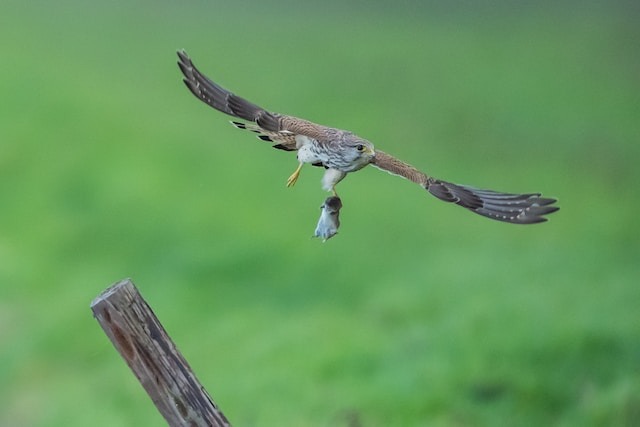
Conclusion
Hawks are fascinating creatures with a crucial role in the ecosystem. While they are known for their sharp talons and powerful beaks, their diet is not limited to small birds and mammals.
Hawks are opportunistic predators that will eat a variety of prey, ranging from insects to reptiles, and even fish.
Factors such as location, habitat, and seasonality can influence a hawk’s diet, making it a complex and dynamic area of research.
Despite their predatory nature, hawks are also an essential part of our ecosystem.
They help control populations of rodents and other small mammals, and their presence can even improve the health of forests and other habitats.
Conservation efforts for hawks are ongoing and are crucial to maintaining healthy ecosystems.
To coexist with hawks in our backyards, it is important to take steps to protect our feathered friends.
Providing cover like trees and shrubs, using bird feeders that are difficult for hawks to access, and keeping bird baths and water sources away from open areas can all help reduce the risk of predation.
By understanding the importance of hawks in our environment and taking steps to protect our backyard birds, we can create a harmonious relationship with these magnificent creatures.

